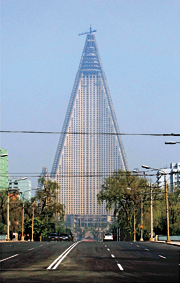In North Korea, signs of recovery

Construction was resumed on the Yukyong Hotel in Pyongyang. By Kang Jung-hyun
Pyongyang’s electricity supply seemed to have stabilized and passersby on the streets looked livelier compared to observations made during the team’s first visit in 2006.
In Pyongyang, the capital, red banners were hanging all over the city, exhorting citizens with slogans such as “Enhance agricultural production, the foundation of a great, strong country” and “Bring a new wave of improvement in the production of consumer products.”
In a joint editorial of the country’s three newspapers published early this year, the North Korean government claimed that the nation will soon be opening to the outside world.
“Opening the door of a great, strong country in 2012 means that we will satisfy the basic needs of the people for food, clothing and shelter and produce 5.5 to 6 million tons of food per year,” said a North Korean official who refused to be named.
The country’s economy collapsed in the mid-90s and hundreds of thousands of people are believed to have died of starvation.
“At the time, all the factories in the county were dying and we lived in a situation that can’t be imagined by anyone who did not experience it. Now we see hope,” said another unamed official.
In a recent closed-door seminar, a Japanese expert on North Korea said that Pyongyang’s budget this year amounted to 101 percent of the year 1989 when the country’s economy reached its peak.
Experts say the recent revival of the North’s economy resulted from efforts of the regime.
“For the past decade, North Korea concentrated its human and natural resources on producing electricity, increasing food productivity and modernizing plants,” said Kim Yeon-chul, a research professor at Korea University in Seoul.
During that time, North Korea built two power plants, modernized a thermal power station and constructed several small and mid-sized hydropower plants, easing the electricity shortage, according to Kim.
A North Korean official of the Korean Council for Reconciliation and Cooperation who was guiding the reporters proudly asked the team, “Have you experienced blackouts in Pyongyang lately?”
The JoongAng Ilbo’s special reporting team visited a beer factory, a breadmaking factory, a clothing factory and a construction material plant in Pyongyang and a ship repair yard in Nampo. All were in active operation. Still, it is too early to expect significant progress in the economy. “Most plants in North Korea have old facilities, built in the ’60s or ’70s,” said an official.
“Until May, we received food without a problem,” said an employee at a restaurant that the reporters visited. “But due to last year’s massive floods, it is likely that we will have a shortage of food in June or July.”
By Special Reporting Team JoongAng Ilbo [soejung@joongang.co.kr]










with the Korea JoongAng Daily
To write comments, please log in to one of the accounts.
Standards Board Policy (0/250자)